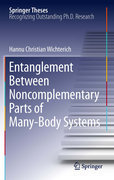
Entanglement between noncomplementary parts of many-body systems
Wichterich, Hannu Christian
This thesis investigates the structure and behaviour of entanglement, the purely quantum mechanical part of correlations, in many-body systems, employing both numerical and analytical techniques at the interface of condensed matter theory and quantum information theory. Entanglement can be seen as a precious resource which, for example, enables the noiseless and instant transmission of quantum information, provided the communicating parties share a sufficient 'amount' of it. Furthermore, measures of entanglement of a quantum mechanical state are perceived as useful probes of collective properties of many-body systems. For instance, certain measures are capable of detecting and classifying ground-state phases and, particularly, transition (or critical) points separatingsuch phases. Chapters 2 and 3 focus on entanglement in many-body systems and its use as a potential resource for communication protocols. They address the questions of how a substantial amount of entanglement can be established between distant subsystems, and how efficiently this entanglement could be 'harvested' by way of measurements. The subsequent chapters 4 and 5 are devoted to universality of entanglement between large collections of particles undergoing a quantum phase transition, where, despite the enormous complexity of these systems, collective properties including entanglement no longer depend crucially on the microscopic details. Nominated as an outstanding contribution by University College London Treats two of the major challenges of modern physics: Entanglement and emergent properties (phase transitions) Provides an excellent theoretical basis for future research INDICE: Introduction. Exploiting Quench Dynamics in Spin Chains for Distant Entanglement and Quantum Communication. Extraction of Pure Entangled States from Many-Body Systems by Distant Local Projections. Scaling of Negativity of Separating Blocks in Spin Chains and Critically.-Universality of the Negativity in the Lipkin-Mechkov-Glick Model. Conclusions and Outlook. A. Diagonalisation of the XX Model. B. Factorisation of the Fermionic Correlation Functions. C. Time Dependence of the Reduced Density Operator Following Quench. D. DensityMatrix Renormalisation Group Algorithm. E. Proof of Williamson’s Theorem. F. Partial Transposition in Continuous Variable Systems. G. Gaussian Wigner Representation of Bosonic Vacuum. H. Ground State Covariance Matrix of a QuadtraticHamiltonean. I. Bipartitie Entanglement of Gaussian States. J. Density MatrixSpectra of Bosonic Gaussian States. K. Bosonisation of the LMG Hamiltonian. Bibliography
- ISBN: 978-3-642-19341-5
- Editorial: Springer Berlin Heidelberg
- Encuadernacion: Cartoné
- Páginas: 100
- Fecha Publicación: 01/04/2011
- Nº Volúmenes: 1
- Idioma: Inglés
